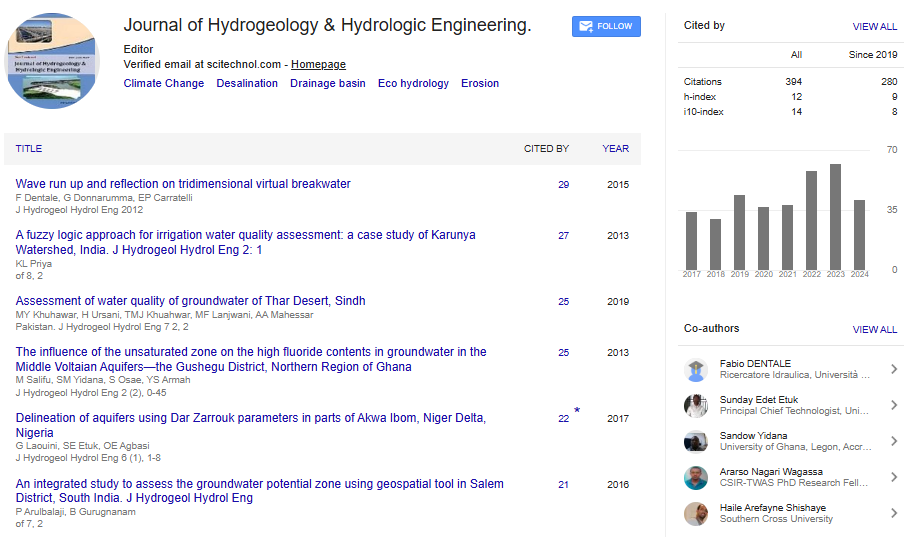Commentary, J Hydrogeol Hydrol Eng Vol: 13 Issue: 2
Green Transformations: Developing Ideas to Address Climate Change
Dougla Michael*
Department of Agricultural Engineering, North Carolina State University, Raleigh, USA
*Corresponding Author: Dougla Michael,
Department of Agricultural Engineering,
North Carolina State University, Raleigh, USA;
E-mail: douglasm11@gmail.com
Received date: 27 March, 2024, Manuscript No. JHHE-24-138802;
Editor assigned date: 29 March, 2024, PreQC No. JHHE-24-138802 (PQ);
Reviewed date: 12 April, 2024, QC No. JHHE-24-138802;
Revised date: 19 April, 2024, Manuscript No. JHHE-24-138802 (R);
Published date: 26 April, 2024, DOI: 10.4172/2325-9647.1000317
Citation: Michael D (2024) Green Transformations: Developing Ideas to Address Climate Change. J Hydrogeol Hydrol Eng 13:2.
Description
Climate change is increasingly recognized as a major factor influencing weather patterns and hydrological events across the globe. One significant impact observed in recent years is the shifting timing of floods in Europe. This phenomenon has profound implications for ecosystems, infrastructure, and human societies. Understanding the drivers and consequences of these changes is essential for developing effective adaptation strategies.
Historically, Europe has experienced seasonal flooding primarily during the spring and summer months. These floods are often driven by snowmelt in mountainous regions and heavy rainfall. However, recent studies have shown a noticeable shift in the timing of these floods, with many occurring earlier in the year or during periods that were previously less prone to flooding.
One of the primary drivers of this shift is the rise in global temperatures. Warmer winters mean that snow accumulation in mountainous areas is reduced, and snowmelt occurs earlier in the spring. This results in higher river flows earlier in the year, increasing the risk of flooding in late winter and early spring. Additionally, higher temperatures can lead to more intense and frequent rainfall events, further contributing to the likelihood of floods outside the traditional flood season.
The shifting flood patterns are evident in several regions across Europe. For example, in the Alps, earlier snowmelt has led to increased river flows in March and April, rather than the traditional peak in May and June. Similarly, the British Isles have seen a rise in winter floods, attributed to more frequent and intense Atlantic storms driven by a warming climate. In Central and Eastern Europe, changes in precipitation patterns have also resulted in floods occurring outside the usual summer months.
The impact of these changing flood timings on European societies and ecosystems is significant. Floods occurring earlier in the year can catch communities off guard, as they may not be prepared for such events outside the traditional flood season. This can lead to higher economic costs and greater disruption to daily life. Additionally, infrastructure such as dams and levees, designed based on historical flood patterns, may no longer be adequate to manage the new flood regimes.
Agriculture is particularly vulnerable to these changes. Crops planted in early spring may be damaged by unexpected floods, leading to reduced yields and financial losses for farmers. Livestock can also be affected, with pastures and feed supplies being inundated. Moreover, changes in flood timing can disrupt the natural life cycles of many aquatic and riparian species. Fish spawning, plant germination, and other ecological processes are closely tied to seasonal water levels, and shifts in flood timing can have flowing effects on biodiversity and ecosystem health.
Addressing the challenges posed by the changing timing of floods requires a multifaceted approach. Improved flood forecasting and early warning systems can help communities prepare for and respond to floods more effectively. Updating infrastructure to withstand new flood regimes is also essential. This includes reinforcing dams and levees, as well as designing urban drainage systems capable of handling more intense rainfall events.
Adaptation strategies should also consider the broader landscape. Restoring natural floodplains and wetlands can provide additional storage for floodwaters, reducing the pressure on man-made infrastructure. These natural solutions not only mitigate flood risks but also enhance biodiversity and provide other ecosystem services.
Furthermore, efforts to moderate climate change by reducing greenhouse gas emissions remain essential. Slowing the pace of global warming can help stabilize weather patterns and reduce the likelihood of extreme hydrological events.
Conclusion
The shifting timing of European floods is a clear indicator of the broader impacts of climate change. As these changes continue to unfold, it is imperative for societies to adapt and mitigate their effects. Through a combination of improved forecasting, infrastructure updates, and natural solutions, Europe can better manage the risks associated with changing flood patterns, protecting both human and ecological communities.
 Spanish
Spanish  Chinese
Chinese  Russian
Russian  German
German  French
French  Japanese
Japanese  Portuguese
Portuguese  Hindi
Hindi 
